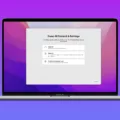Are you considering trading in your Mac? There are a few things you should do before making a decision. Since Macs are highly valuable, it’s important to take the time to prepare your device for trade-in so you can get the most out of it.
The first step is to cancel or transfer your AppleCare coverage. Depending on how long you’ve had your Mac, there may be different ways to do this. Apple offers several options that include transferring coverage to another person and canceling with a full refund.
Once that’s taken care of, you’ll need to erase all content and settings from your Mac. This will ensure that no one else has access to any personal information stored on the device. You can do this through the System Preferences menu by clicking on “Transfer or Reset” and then select “Erase All Content and Settings”.
Another important step is to back up or transfer all of your files from your Mac before trading them in. You can use an external hard drive or cloud storage service like iCloud or Dropbox for this purpose. Once all of your files have been safely backed up, sign out of iTunes, iCloud, and iMessage so no one else has access to them either.
Finally, if you use Bluetooth devices with your Mac, make sure to unpair them before handing it over too. This will prevent anyone from being able to connect with those devices using your Mac after the trade-in process is completed.
When you’re ready, erase your Mac and reinstall macOS by pressing Option-Command-P-R when turning on the device until you hear two startup tones. This will clear user settings from memory and restore security features that might have been altered previously as well as reset NVRAM (Non-Volatile Random Access Memory).
By following these steps when prepping for a Mac trade-in, you can make sure that everything is safely transferred while also ensuring that no one else has access to any sensitive data stored on the device. Doing so will not only help protect your privacy but also increase the value of your Mac when trading it in!

Preparing a Device for Trading on Mac
Before trading in your Mac, it is important to properly prepare the device so that you can get the most value out of it. To start, you should cancel or transfer any AppleCare coverage associated with the device. If available, use the ‘Erase All Content and Settings’ option in System Preferences which will delete all personal information from your Mac. It is also important to back up or transfer any stored files and content such as photos, documents, etc. Additionally, make sure to sign out of iTunes, iCloud, and iMessage as these services are all associated with personal accounts. If you have any Bluetooth devices paired with your Mac, be sure to unpair them as well. Finally, erase your Mac and reinstall macOS to restore it back to its factory settings. By following these steps you should be able to trade in your Mac efficiently and safely.
Wiping an Old IMAC Before Returning It as a Trade-In
To wipe an old iMac before returning it as a trade-in, you will need to erase all content and settings. To do this, go to the Apple menu. in the corner of your screen and choose System Settings. Next, click General in the sidebar and then click Transfer or Reset on the right. Finally, click Erase All Content and Settings. This will reset your iMac to its factory settings and remove any personal data from your device. Once complete, you can safely trade in your iMac for a new one.
Reinstalling Mac Before Trade In: Do I Need To?
Yes, it is important to reinstall your Mac before you trade it in. Doing so will help ensure that your data and personal information are erased from the computer and not accessible to the new user. To reinstall macOS, you will need to erase the hard drive of your Mac. This can be done by restarting your Mac, pressing Command-R on the keyboard during startup to enter the recovery mode menu, and selecting Disk Utility from there. Once Disk Utility is open, select the disk that contains macOS in the sidebar and choose “Erase” from the Edit menu. Next, quit Disk Utility and select Reinstall macOS from the recovery mode menu. Finally, follow the onscreen instructions to download and install a clean version of macOS on your Mac.
Completely Wiping a Mac to Sell It
To completely wipe a Mac before selling it, the best option is to use Apple’s own disk formatting tool, Disk Utility. To access this tool, restart your Mac and press Command-R as it boots up to enter Recovery Mode. Select Disk Utility from the Utilities window that appears and choose your startup disk from the list of drives that appear. Click on the Erase tab at the top of the window and select Mac OS Extended (Journaled) as your format type. Finally, click Erase and wait for the process to finish before exiting Disk Utility.
It is also important to deauthorize any services you have used with your Mac such as iTunes or iCloud. To do this, open System Preferences, select iCloud, then click “Sign Out” at the bottom of the window. You may also need to deauthorize any other services associated with your accounts such as Apple Music or iTunes Match by visiting those respective websites or apps.
Once you have wiped your drive and deauthorized any services associated with your account, you can sell your Mac knowing it will no longer contain any of your personal data.
Unable to Access ‘Erase All Content and Settings’ on Mac
If you are unable to see the Erase All Content and Settings option, it is likely because your Mac does not have either Apple silicon or the Apple T2 Security Chip. This feature is only available on Macs with these components, as they are necessary for this data-wiping process. If your Mac does not meet these requirements, you will not be able to use Erase All Content and Settings.
Erasing All Content and Settings on a Mac
To erase all content and settings on your Mac, first, go to the Apple menu > System Preferences, then click General in the sidebar. On the right side, you’ll see a section titled Transfer or Reset. Click on this and select Erase All Contents and Settings.
You’ll then be prompted to enter your administrator information in order to unlock the Erase Assistant. Once you have done this, review all items that will be removed as part of erasing all content and settings on your Mac. Once you are ready, click Erase Now to begin the process.
Note that erasing all content and setting is permanent, so make sure you have backed up any important data before continuing.
Cleaning Up an Old Mac Before Transferring to a New Mac
Before transferring your data from your old Mac to your new one, it’s important to do a thorough clean-up of the old computer first. Here are some steps you can take to ensure that your data is properly cleaned and organized before the transfer:
1. Upgrade any applications that need updating.
2. Back up all of your data in case something goes wrong during the transfer.
3. Perform system updates to make sure everything is running smoothly on the old computer.
4. Clean out temporary files and cache folders that have been accumulating over time.
5. Perform a full-system scan for malware and update your security software if needed.
6. Scan and fix permissions on all files and folders to make sure they are accessible on the new computer when transferred.
7. Uninstall any unused applications or programs that you no longer need or use on the old Mac to free up storage space for the transfer process to run smoother and faster.
8. Lastly, use Apple’s Migration Assistant tool to transfer all of your system information from one Mac to another safely and securely before starting fresh with the new machine!
Saving Data Before Wiping a Mac
In order to ensure that you do not lose any important data before wiping your Mac, it is important to save the following items:
1. Your personal files, including photos, documents, and music.
2. Any app-specific settings or preferences stored on your Mac.
3. All of your usernames and passwords are associated with third-party websites or services.
4. Any licenses or serial numbers associated with software installed on your Mac.
5. Any widgets, snippets, or plugins you have installed in apps on your Mac (such as TextEdit).
6. Your Time Machine backups (if applicable).
7. Your macOS user account preferences, such as desktop wallpaper and system sounds.
8. Any other customizations you have made to the appearance of your Mac (such as icon sizes).
Does Reinstalling MacOS Erase All Data?
No, reinstalling macOS will not wipe everything. When you reinstall macOS from Recovery, only system files and settings will be affected; all of your data and personal files will be retained. If you choose to erase your main drive, then that is when everything on it will be wiped.
What Happens to Your Mac When You Trade It In?
When you trade in your Mac, we’ll inspect it and verify its condition. If everything checks out, we’ll process the trade-in and credit your original purchase method. We’ll also arrange for you to send it to us. Once we receive it, we’ll securely erase all of its data and repurpose it for reuse. This helps reduce the amount of electronic waste generated by our customers and contributes to a more sustainable environment.
Conclusion
In conclusion, Macs are reliable, user-friendly computers with many powerful features. They offer excellent performance, and long battery life and are compatible with many different software programs. Macs also features a variety of security measures to protect your data, as well as an array of customization options to suit your individual needs. Whether you’re looking for a computer for work, school, or entertainment purposes, Macs are sure to meet your requirements. With the right settings and maintenance, you can enjoy years of use with your Mac.








